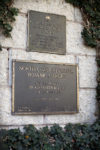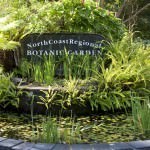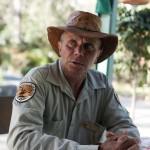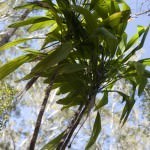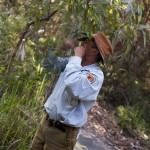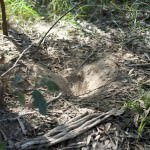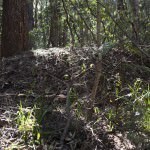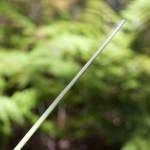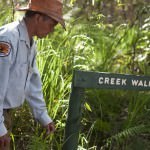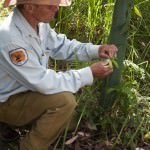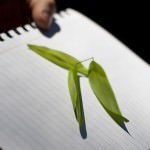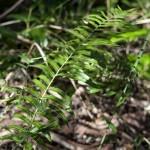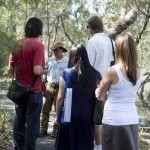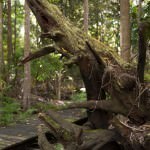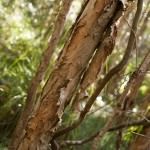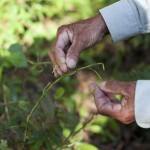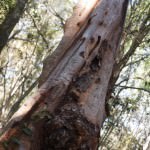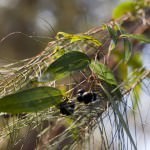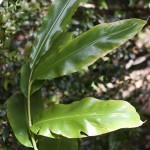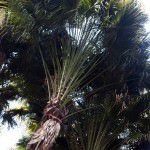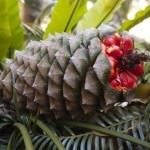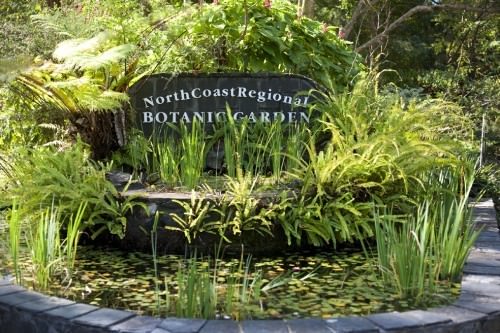
What a glorious day for a stroll through the North Coast Regional Botanic Gardens! I am meeting my friend and fellow food writer Lorraine Elliott from Not Quite Nigella to participate in an indigenous bush tukka tour.
The tour is being held at the Coffs Harbour Botanic gardens and conducted by Mark Flanders from National Parks & Wildlife. Mark is an elder of the local Gumbaynggirr people and a Senior Site & Heritage officer for the Coffs Harbour & District local Aboriginal land council. As a young boy he grew up playing and foraging in the area which is now the Botanic Gardens.
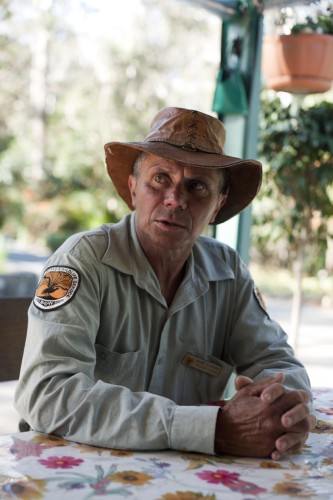
Leading the discovery tours allows Mark to share the culture and knowledge of the local indigenous people with the wider community. The Gumbaynggirr people have a rich heritage and a comprehensive understanding of the plant and animal life. By leading these tours Mark ensures that the knowledge of his people is understood and appreciated. He explains that education is the key to keeping the aboriginal culture alive and integrating it into modern life. He reminds us that Australia is a multicultural country and we are always adapting to adopt flavours from various cuisines. The bush food is another way we can add an element of Australiana to our cooking.
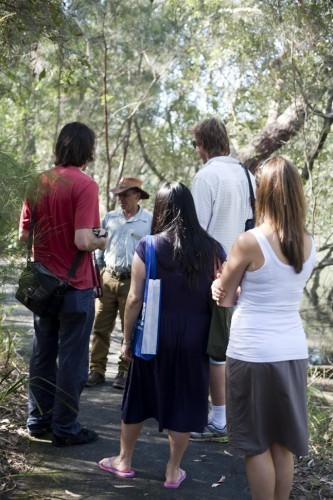
We commenced our walk; Mark lead our group along the path through the botanic gardens whilst he continued to explain the importance of “land” to his people. “Land is life!” “Bush food is food and medicine” “The land gives us our food, medicine and resources for clothing and shelter.” “The bush is the Aboriginal mans supermarket, chemist and hardware store. Everything we need is on land”. He explained that the Aboriginal elders have lived in tune with the land, and learned to rely on, and be a part of, the seasons and cycles of the land. He also announced that he was 150 years of age! The food and medicine of the bush was keeping him young and fit. There were a few giggles at this joke but I really would not be able to guess his age.
Our first stop on our little trek was at a Midgim Berry shrub. This is one of my favourite native berries. It is a little smaller than a blueberry with a similar texture. The flavour is a cross between Eucalyptus and blue berry. It is a very rich source of vitamin C. Mark explains that it is a little too early in the season for the berry, but he noted that the bush was just starting to develop flowering buds which will go on to produce the edible berry.
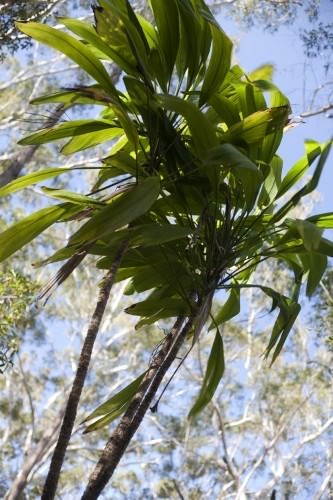
Next we are shown a tree known as a walking stick palm. This palm only grows to about three meters and is valuable to aboriginal people as it has many uses. Mark explains that the plant produces edible sweet red berries on a long strand that are commonly eaten. The tree itself gets its name because it has been commonly used to make walking stick, although the aboriginal people have also used it for spears in the past.
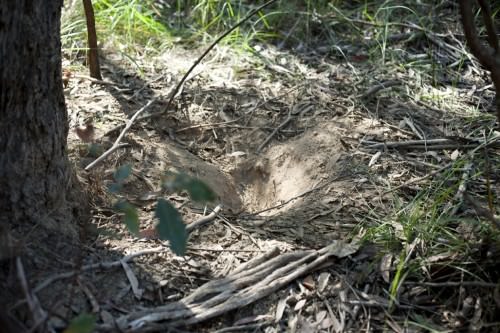
As we are walking we are shown a burrowed hole which Mark explained would have been made by an Echidna or Muugi. Eating the Echidna is usually reserved for the elders as the meat is very soft, easy to eat and a delicacy.
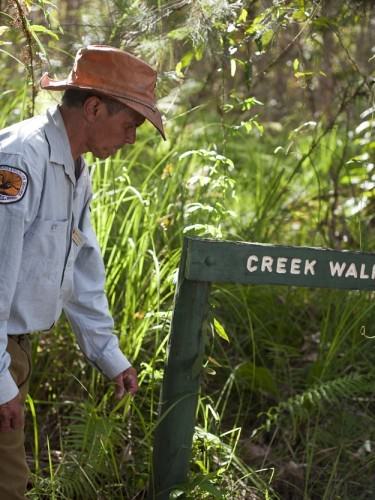
As we are walking amongst the bush we are given more insight into the harmonious way the indigenous interacted with the land and the seasons. For example Mark explained that by watching what was happening in the bush to the plants, the aboriginal people could tell if the winter was over. They didn’t need a calendar; a few buds on a plant would signal the change in season. Spring meant the Gumbaynggirr people would stop hunting animals (giving the animals an opportunity to produce young for the next winter.) The Gumbaynggirr would use the spring to forage for plant food.
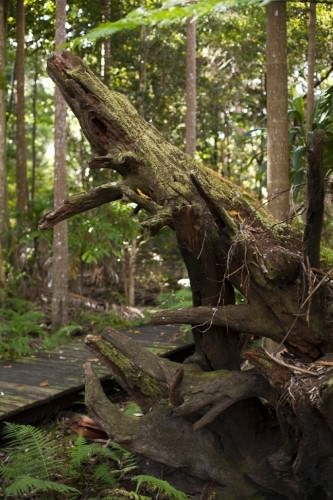
We meander down the path tho the creek edge and are show a series of River Oaks which have fallen in the water. Mark explains that once the trees have fallen in the water they become home to a large worm which grows more than a meter long. The worm is called a Cobra Worm and is eaten raw after pulling its head off! Thankfully I am not the only one in the group that cringes at the thought of eating a big raw worm! I was very pleased that this treat was not on the tasting list today! Mark insisted that eating the worm was just like eating oysters. He said that the taste is very milky and the worm itself is a very powerful medicine.
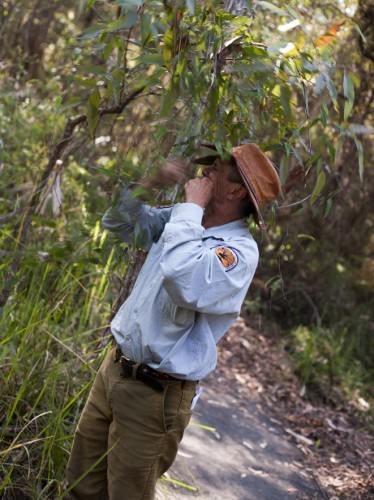
The next plant we are introduced to is the Sweet Sarsaparilla. We each sample a new pink leaf and find that it does have a strong sarsaparilla flavour. We are told that it cleans the blood and is also full of vitamin C. The leaves can be steeped in warm water to make or tea or simply chewed.
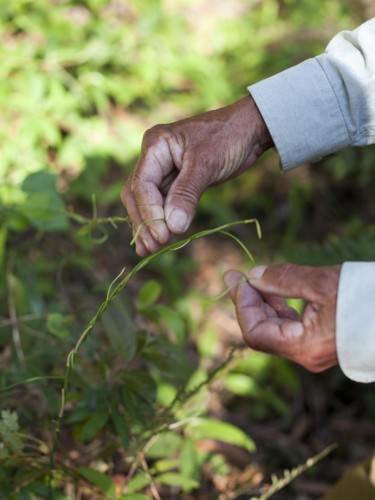
As we continue our walk we spot the scratching of the bush turkey. We are told that these birds also make good eating. Mark shows us a huge pile of leaves which he explains is the bush turkey’s nest. The bird scratches all the leaves and twigs into a large mound and the warmth generated by the decomposing material is what keeps the eggs warm and incubated. The female simply lays the eggs and leaves, it is the male bush turkey that is left to add or subtract leaves to keep the eggs at the optimum temperature. Each nest can house up to 100 eggs!
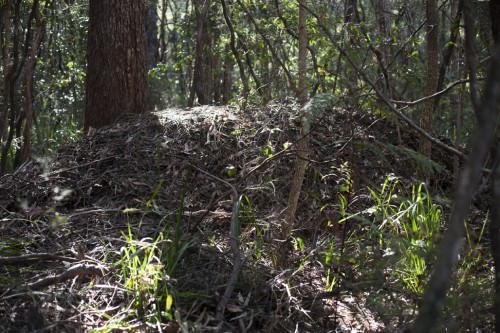
Native Asparagus is a pleasant surprise to the palate. It is gathered and eaten as any salad leaf would be in our modern cuisine. The flavour is very similar to snow peas and Mark mentions that in his household there is a melding of traditional food with modern Australian fare and this leaf would be included in a regular salad. This plant also produces edible shoots which are only very thin but have the texture of a baby asparagus and the flavour of sprouts. I would happily and the leaf and the shoot to my home salad.
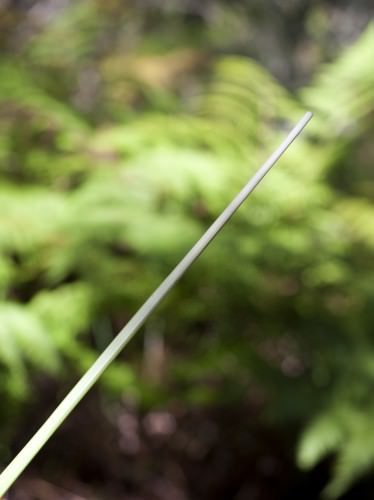
Next on our shopping list of native foods was the Saw Sedge. This grass is very sharp but Mark shows us exactly how to extract the stem safely and we are each given some to try. The grass has a white base which is surprisingly nutty in taste and texture.
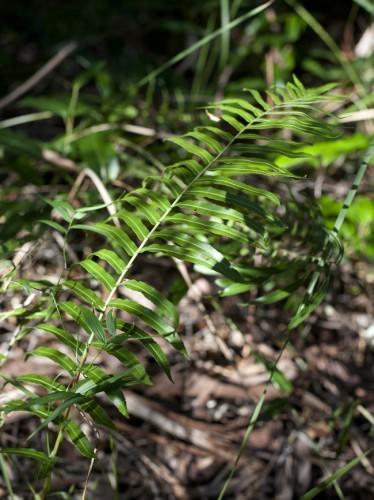
As we walk along I am surprised by how many of these everyday plants are actually edible. We stop at a Bungwahl Fern and Mark explains that these ferns are picked and the ryzones are cooked on the fire.
We pass a paper bark tree along the path and it is introduced to us as the “Black Fellas al foil.” The aboriginal people would wrap meat in the wet bark and cook it over the fire. This also gave the food a distinctive smokey flavour.
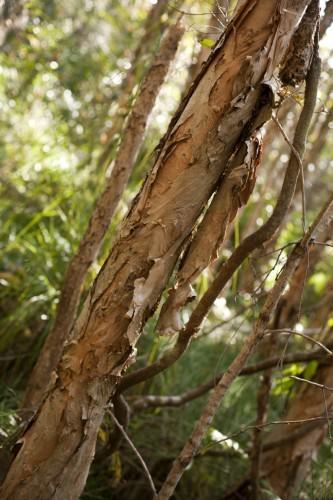
Where there is paper bark there is swamp and Mark explains that in the wet the area we are walking across can be quite muddy. We have the benefit of an elevated boardwalk but as a child Mark and his friends would catch lizards snakes and turtle in these swampy areas. He laments that the only problem with the turtle is that the Coffs area had an abundance of stink turtles so before the meat could be eaten he had to remove the stink gland so the meat would not be ruined.
Another valuable plant to the indigenous people was the Sandpaper Fig. This tree produces and edible fruit which is about 2cm in diameter and purple in colour. It has a furry skin which needs to be removed prior to eating. Mark also explained that the leaf was used by the Gumbaynggirr people to smooth the wood when they were making tools and weapons.
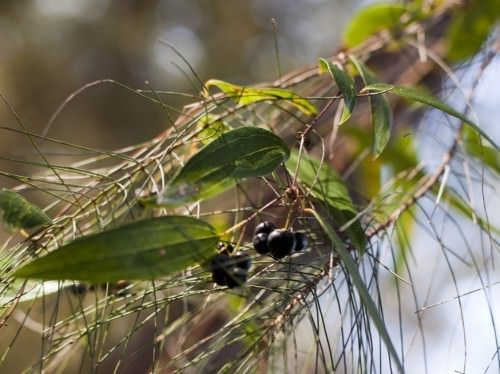
There are so many foods on the tour, some tasty… and others not so much, but it was such an amazing tour as I would have simply walked past these plants and not realised their benefits both nutritional and medicinally.
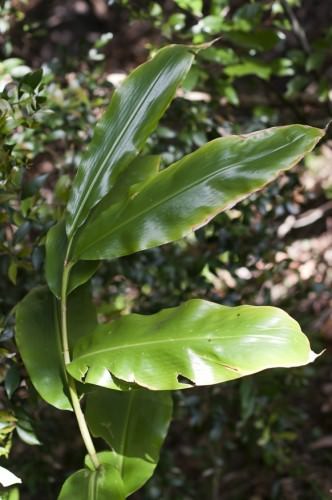
We continue through to the edge of the swamp where there is more light and we’re shown a native ginger plant. This is a broad leaf plant which the aboriginals used in many ways. The leaf is used in cooking to wrap meat, and the young roots are used in a similar way to the ginger we are accustomed too. The plant also produces fruit which was a lemony flavour and is safe to eat.
Alongside the Native Ginger was a vine called the spiky Sarsaparilla which had large shiny leaves Mark called dinner leaves. This plant was used as a thirst quencher.
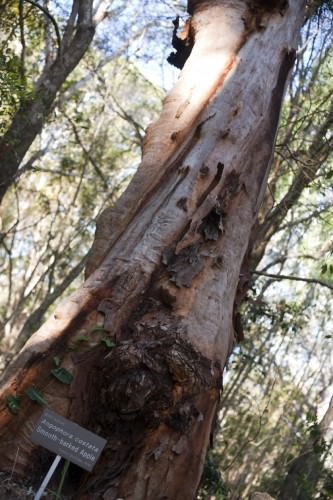
At the edge of the botanic garden we came to a large tree which I recognise immediately as the Aniseed Myrtle. It is an attractive tree which can grow quite large. As the name suggests its leaves have a strong aniseed aroma and flavour. By crushing the leaves the oils are released and the fragrance is quite strong. The nicest leaves to eat are the young red leaves, as these are tender and soft so the taste is just like eating a liquorice lolly. Mark explained that the leaves are for energy “like black fella speed.”
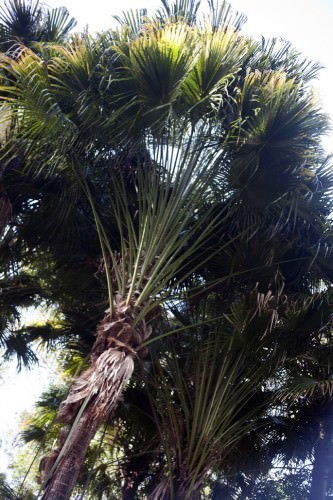
We make our way toward the entrance of the botanic gardens where we stop under a Cabbage Tree Palm. Mark explains that the young and tender unfolded leaves of this plant can be eaten like cabbage. The leaf buds at the very top of the plant are also edible but, since the plants are unable to produce side-shoots, this will actually kill the plant so the aboriginal people would avoid eating them.
As a conclusion to the tour Mark shows us a Burrawong Palm. The seeds from this plant are a good source of starch but are poisonous to eat. The Aboriginals realised the poison needed to be leached from the seeds prior to consumption. To remove the poison they would ground the large seeds and place them into a “dilly bag.” The Dilly bag was then secured in a fast flowing stream and allowed to wash for a week before use. With the toxins removed it was then safe to use the starch to make “Johnny cakes” which would be cooked over hot embers.
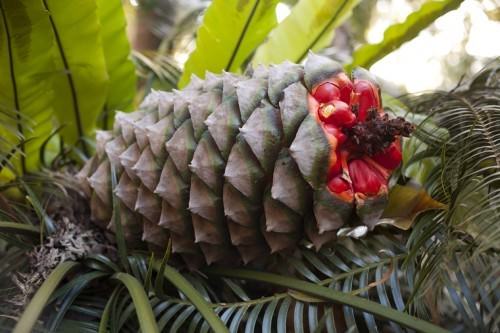
Some of the other National Park Discovery Tours which are available locally are;
Muttonbird Moonlight Tours
Whale watching headland Tours
Bush Tukka & Medicinal plant Tour
The cost to book a tour is $180 for a group of up to 20 people and the tour runs for between 1 ½ to 3 hours. Bookings are essential and should be made approximately two weeks in advance to avoid disappointment.
Gourmet Getaways would like to thank Lorraine from “Not Quite Nigella” and Coffs Coast Marketing for organising the day.
Next stop on our itinerary is the Cheesemaking Workshop at Moonee, and then we will be enjoying a meal at Latitude 30! So stay tuned for more…
All images are subject to copyright restrictions but are available for sale as a package or singularly. Please feel to contact me for a rate schedule.
